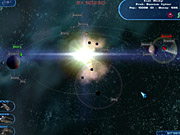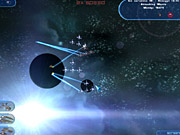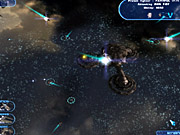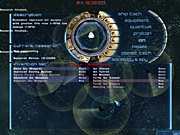What's in a name? In the case of Hegemonia: Legions of Iron, it sets the tone for a game that's solid in concept--though one that isn't particularly accessible to those who don't read the manual and that never loses its European accent, even though Dreamcatcher did drop the "a" from "Haegemonia" for the US release. Hegemonia may look a lot like Homeworld and the recently released O.R.B., but it doesn't conform completely to the kind of conventions that these 3D space strategy games set. The game trades tactical depth for broad strategy, much like the developer's Imperium Galactica space empire games. However, Hegemonia is essentially the first real-time space empire game that lets you sit down and play a quick multiplayer match. But while this hybrid concept mostly works well, the game suffers from a lack of polish and from stripped-down combat balance.

It's not often that we see a real-time strategy game that's both solid and unconventional. But Hegemonia didn't just appear out of nowhere. It's been well over two years since Digital Reality produced Imperium Galactica II, which distinguished itself from classic space empire games like Master of Orion with a heavily scripted, story-based campaign and with effective real-time mechanics. Elements of Hegemonia's presentation, particularly on the strategic overview screen and in the colony management screens, are highly reminiscent of Imperium Galactica II, but certainly the pacing, missions, and combat are all more like what you'd expect in a traditional real-time strategy game.
One of the most appealing things about a 3D space strategy game is the ability to lead sizable space fleets into 3D battles. Like Relic's groundbreaking game Homeworld, Hegemonia has a robust graphics engine that lets spaceships fly not only along a 2D plane, but anywhere in 3D space. In Hegemonia's case, this feature isn't all that important for getting a tactical or strategic advantage, but it does make the game's setting much more believable--the game's excellent graphics help make you feel as though you're actually fighting battles in the middle of outer space.
All of Hegemonia's maps are composed of at least one big, impressive-looking star system, complete with a star that will burn up your ships if you get too close, plus a number of planets set in concentric orbits. The single-player game starts off quite specifically in Earth's solar system. You can choose to start the game playing on the side of either Earth or Mars; according to the game's story, the two planets are at war. The fact that the game has three species--the humans, kariak, and darzok--is one clue that this early human war doesn't last much longer than a series of tutorial missions, but even in later missions, having to defend the solar system and its easily recognizable planets does make success seem more urgent.
Hegemonia's missions are heavily scripted around story events. This helps keep the campaign from devolving into simple wipe-out-the-enemy missions, and even when conquest becomes your eventual goal, you'll still go through a good variety of steps to get there, like having to first protect a spy or destroy enemy production ships. There are a few missions with secondary objectives that can provide an additional ship or a hero that can come in handy, but they're generally an exception. The main problem with the scripted missions is that the specific objectives aren't always clear from the briefing, and at the start of the game, it's easy to miss the list of objectives that's on the initially unimportant empire information screen. We encountered a couple of frustrating scripting bugs that forced us to retry missions without ever knowing what had gone wrong the first time. It also doesn't help that, while there are a few good plot developments, the game's talkative characters are quite drab. The talking-head sequences feature lots of generally comprehensible but awkward English with occasional French and German expressions.

Hegemonia hasn't made any strides past Homeworld's innovative gameplay structure in making it easier to make precise ship movements in 3D, but fortunately, the game rarely requires any sort of precision. Travel between systems is accomplished via wormholes, not tricky hyperspace jumps, and every map has lots of landmarks that can be moved to directly with a right-click, rather than by manual control. The game has two main views, a tactical view that can be zoomed in to see ship battles in great detail and a strategic view that's also in 3D but fudges some of the detail necessary for close combat to instead provide a higher-level view. The strategic map is mostly useful as a quick 2D reference, as ships are represented by simple 2D icons, and ships' and planets' radar ranges are clearly marked, but even in this view, you may need to rotate and zoom the camera to select units that are near each other. Unfortunately, the strategic map doesn't have Homeworld's useful top-down perspective, and it can often flop into an awkward angle after switching views.
The game's interface works well once you get used to it, but it does have notable limitations. When you do need to use manual 3D movement, it's extremely awkward. It's also very difficult to see the Z-axis marker relative to the plane you're viewing. Given that one of the game's most attractive features is having multiple star systems in a single map, it's too bad that you can't select a ship in one system and right-click on a location in another system to have it move there. You can assign your ships to control groups, but they work only in the star system you're currently looking at. Movement between star systems is limited to flying to a wormhole, then having to come back to the connected wormhole later to gather your ships once they've moved through it. Switching between wormholes, while also checking on your faction's production and research, can become cumbersome when Hegemonia's action becomes hectic.
Hegemonia's grand space strategy heritage is obvious when looking at the game's secondary screens. Each planet has a management screen, which presents information--like the tax rate, a slider that emphasizes either research or production, and a four-slot production queue--in a convenient manner. The planet itself is displayed in 3D as it appears in the tactical view, sharply textured depending on its environment type, and each planet's appearance can actually change after terraforming. This last visual detail is the likely culprit for the slowdown that can often occur when switching between planets on low-end systems. The sophistication of the game's tech tree--complete with more than 200 ship, weapon, and infrastructure technologies--means research has a whole screen of its own, but unfortunately there's no way to queue up multiple technologies to research. In a nice touch, research carries over from mission to mission in the campaign, and strategic research choices are constrained both by the resource cost of funding research labs and by the number of research points you have.

Arguably, Hegemonia does a better job with colony and resource management than it does with tactical combat, in part because of a very low limit on the number of ships you can control at once. On larger maps, it's not uncommon to have six or more planets under your control at one time, but you'll have fewer than 10 groups of military ships at once. Combat ships come in four classes--fighters, corvettes, cruisers, and battleships--and the three smaller classes have multiple ships per group, from two for the cruisers to seven for fighters. Only one factor helps minimize the impact of this low unit cap, and that's the fact that a smaller ship class is dramatically weaker than a larger ship. While a few full fighter squadrons can defeat a four-corvette group, fighters are completely useless against cruisers and battleships. Corvettes aren't terribly useful later in the game either.
Hegemonia's unit cap can be frustrating in the context of the campaign, since the game never actually gives you any sort of reason why you can't build a ship you can otherwise easily afford. There is a separate limit on spy ships and special ships, which have separate displays in the lower-left part of the screen, but the special ship limit is the most arbitrary of all. This limit applies to defensive military bases, radar probes, combat support ships like minelayers and repair ships, and the game's three types of resource ships: mining bases, merchants, and wreckage recyclers. The unit limits depend on the map and cannot be increased, so you'll often have tough choices to make. However, Hegemonia's unit limits help balance out the game's multiplayer a bit, since you can't simply churn out lots of defensive stations or even resource ships. It can be very rewarding to hunt out and harass resource ships with fast-moving fighters that you might otherwise not be using.
The combat doesn't lend itself well to tactical subtleties. It can be interesting to use the 3D planets and moons as cover for an approaching attack or retreat, but there's otherwise fairly little maneuvering or micromanagement to do. Despite the small number of units that the game's unit cap affords, there isn't much to do in a battle between two lone ships, and it's often impossible to retreat ships from a major battle without losing them all. Fortunately, it's not hard to build more.
Hegemonia wasn't really designed with a traditional rock-paper-scissors game balance in mind, but the game has four types of weapons and a few minor differences between the game's three races. The three main weapon types--proton, ion, and quantum--aren't radically different from each other and don't have specific counters. The proton weapons use basic particle projectiles; the quantum weapons are similar but are slightly weaker and deal bonus damage within an area of effect; and the ion weapons have visually impressive special effects, do direct, instantaneous damage, and have a small chance of disabling shields. Ships can have only one main type of weapon, so it's best to use missile weapons only on secondary ships, since researching a major upgrade can seriously reduce their ship-to-ship effectiveness. However, missile weapons are the best way to take over planets, which are captured simply by disabling planetary weapon upgrades and bombarding the surface until the planet's morale drops as a result of casualties, causing it to eventually riot.
One of Hegemonia's greatest strengths is its graphics. In promoting the game, the developer specifically aimed to support DirectX 8.1 effects on GeForce3, Radeon 8500, and better graphics cards, and it shows. The lighting effects on the stars look particularly good, from the tremendously bright young blue stars to solar flares on older yellow stars. The game's planets are all nicely detailed and cast correct shadows from the star's direction. The huge scale of the game means that you don't spend much time zoomed in close enough to see ship details, and that's just as well, since Hegemonia's ship designs and effects aren't as remarkable. Other than the way fighters swarm in and around bigger ships, Hegemonia's battles look fairly static.

The game's production values don't stand out as much in other areas, but they are generally solid. Apart from the dreary voice acting during the briefings, the unit speech is fine. The unit confirmation voices are effective and are fortunately in English and not in made-up alien languages (as they are in the recently released space strategy game O.R.B.). The music varies appropriately, if not contextually, from thundering military suites to ambient space fare. Hegemonia's real problem is its interface. The most obvious example of the game's problematic interface is that there's no menu option for a single-player skirmish game. You might not even know the game has a skirmish mode unless you stumble on the fact that it's possible to turn on AI opponents if you choose to host a game without other players. Tooltip hints would have been very useful in this and other situations.
Since Hegemonia's single-player campaign is solid but not exceptional, what makes the game easy to recommend to those who like space strategy games are its skirmish and multiplayer modes. The game doesn't ship with many built-in maps and doesn't have a random map generator, but the maps that are included are interesting and balanced, and they range from small, quick two-player affairs to huge maps intended for eight players. A newly released patch has added in the option of saving the game when playing skirmish or cooperative campaign missions with one other player, but there's no save support for large multiplayer games. In multiplayer matches, games can take as little as an hour with two players at higher speed settings, so Hegemonia seems like the closest thing yet to a fast-paced multiplayer space empire game. Hegemonia's solid, innovative gameplay and technically impressive graphics may seem very appealing to space strategy fans, but it's too bad that the game isn't more accessible and more polished.